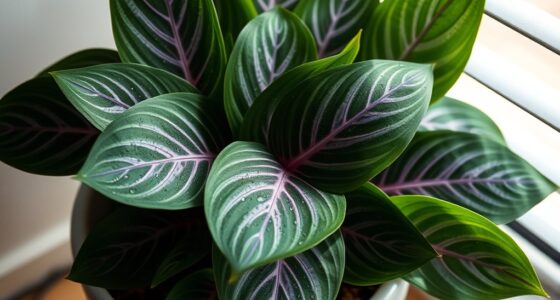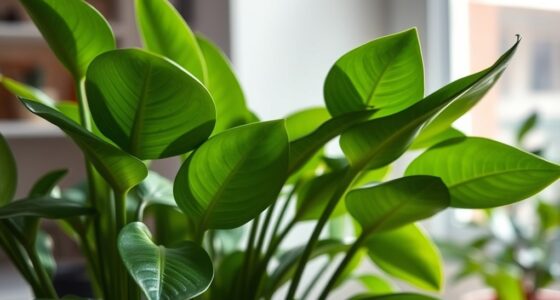To keep your Boston Fern’s fronds lush and free of crunch, guarantee good air circulation around the plant by placing it in a well-ventilated spot and avoiding stagnant areas. Maintain consistent humidity by misting the fronds regularly and watering the soil properly—not too much or too little. Watch for pests and treat them promptly. Balancing airflow, moisture, and pest control helps your fern stay vibrant; learn more to master these care tips.
Key Takeaways
- Ensure proper air circulation to reduce humidity buildup and prevent frond dehydration.
- Maintain consistent watering and mist fronds regularly to keep humidity high and prevent tips from drying out.
- Avoid overwatering and use well-draining soil to prevent root rot and excess moisture that cause crunchiness.
- Inspect for pests frequently and treat infestations promptly to prevent damage to the fronds.
- Keep the fern in a location with filtered light and good ventilation to support healthy, vibrant, crunch-free fronds.

Are you wondering how to keep your Boston Fern lush and vibrant? The key lies in creating the right environment and maintaining consistent care. One of the most important factors is guaranteeing proper air circulation around your fern. Good airflow helps prevent the buildup of humidity that can promote mold, mildew, and pests. Place your fern in a spot where fresh air can circulate freely, such as near a window with filtered light or in a well-ventilated room. Avoid crowded spaces or areas with stagnant air, as these conditions can lead to problems like leaf rot and pest infestations. When air moves gently around the plant, it also encourages healthy frond growth and helps prevent the development of crunchy, brown tips that often indicate stress or dehydration.
Pest prevention is another vital aspect of maintaining a healthy Boston Fern. Keep an eye out for common pests like spider mites, scale insects, and mealybugs, which thrive in humid environments and can cause fronds to yellow, wilt, or become sticky. Regular inspection of the undersides of leaves and the base of the plant allows you to catch any pests early before they spread. If you notice pests, treat the fern promptly with insecticidal soap or neem oil, following the product instructions carefully. Quarantining new plants before introducing them to your existing collection is also wise, as it prevents pests from hitchhiking into your healthy plants. Combining pest prevention with good air circulation creates an environment where pests find it difficult to establish themselves, keeping your fern healthier and free of damage.
Additionally, maintaining proper humidity and watering routines supports the overall health of your Boston Fern. Mist the fronds regularly to boost humidity and mimic its natural environment, but do so in conjunction with proper air circulation to avoid excess moisture that can lead to fungal issues. When watering, ensure the soil stays moist but not soggy—overwatering can weaken the roots and invite pests. Using a well-draining potting mix helps keep excess water away from the roots, further discouraging pest problems and rot. By paying attention to these details—air circulation, pest prevention, watering, and humidity—you give your Boston Fern the best chance to flourish. Healthy fronds will emerge lush, green, and without crunch, transforming your space into a verdant oasis. Consistent care that balances airflow, moisture, and vigilance against pests guarantees your fern remains vibrant and resilient for years to come.
Frequently Asked Questions
How Often Should I Fertilize My Boston Fern?
You should fertilize your Boston fern every 4 to 6 weeks during the growing season, typically spring and summer. Stick to a balanced, water-soluble fertilizer to meet its nutrient requirements, but avoid over-fertilizing, which can cause fronds to become crunchy. In fall and winter, cut back on fertilization since the plant’s growth slows. This fertilizer schedule keeps your fern healthy and lush without risking frond damage.
Can Boston Fern Survive in Low-Light Environments?
Think of your Boston fern as a chameleon, adapting to its surroundings. It can survive in low-light environments, but it might not thrive as brightly as in indirect sunlight. While fern adaptation allows it to manage low-light survival, you should still provide some gentle, filtered light to keep it lush. Proper care guarantees your fern stays healthy, even when light is limited—think of it as giving your plant a little extra love.
What Are Common Pests That Affect Boston Ferns?
You should watch out for common pests like aphid infestations and scale insect problems that can harm your Boston fern. These pests feed on the fronds, causing damage and weakening the plant. Regularly inspect your fern for sticky residue, tiny insects, or discolored fronds. If you spot pests early, you can treat them with insecticidal soap or neem oil to keep your fern healthy and vibrant.
How Do I Propagate My Boston Fern?
You can propagate your Boston fern through fern division or leaf propagation. For fern division, gently remove the plant from its pot and separate the root clumps, ensuring each has healthy fronds and roots. Plant these divisions in moist soil. Alternatively, for leaf propagation, cut a healthy leaf, insert it into moist soil or water, and wait for new roots and fronds to develop. Both methods are effective and straightforward.
Is It Safe to Keep Boston Ferns Around Pets?
You might think Boston ferns are pet-friendly, but they’re actually toxic to cats and dogs. So, while they add lush greenery, pet safety comes first—keeping your furry friends away from these plants prevents toxicity concerns. Ironically, what looks harmless and beautiful can pose a health risk. If you want a safe, vibrant fern for your pets, consider non-toxic options. Always check plant safety before introducing new greenery to your home.
Conclusion
Now that you’ve mastered Boston fern care, your lush fronds will dance with energy—no crunchy tips in sight. Imagine your fern as a pampered diva, sipping misty cocktails and lounging in perfect humidity, never suffering from dryness or neglect. With just a little attention, you’ll have a vibrant green masterpiece, turning your space into a tropical paradise. So go ahead, give those fronds the spa treatment they deserve—your fern’s future looks lush and crunchy-free!









